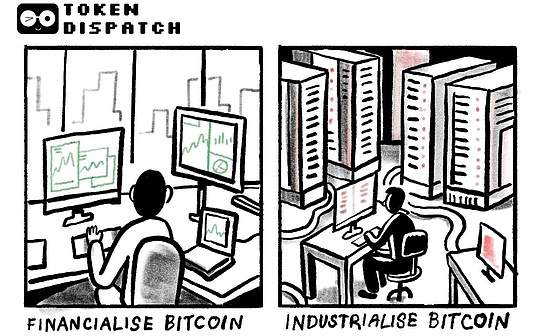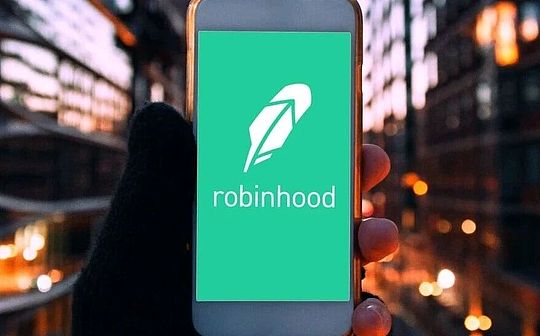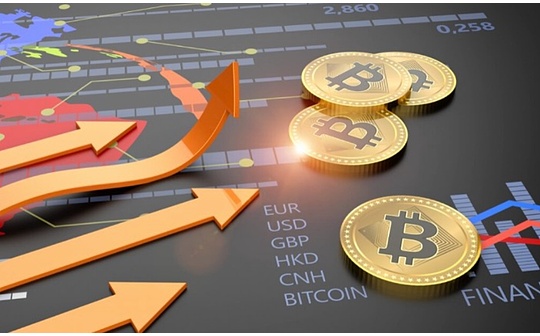
Author: Thejaswini M A Source: token dispatch Translation: Shan Oppa, Bitchain Vision
“The king is dead, long live the king.”
This declaration echoed at the Palace of Versailles on May 10, 1774.Louis XV just died.In a moment, the nobles who had bowed to him turned and left, flocking to the next king.This is not cold-blooded, it is survival instinct.
The French know a truth about power:Power never belongs to anyone.It’s like water, always looking for the next container.This declaration is not mourning the dead king, but acknowledging the living.The formerKing, today may have become a footnote to history.Changes come quickly, coldly and inevitable.

Power requires this indifference.The empire rose on the corpses of its ancestors.The new ruler inherited the old throne.This cycle goes on and on.And now,The memecoin Launchpad layout on the Solana chain is performing this ancient ritual section.
Pump.fun is the undisputed overlord, and it was mastered a month ago88% Market shareofPump.fun, now only13%, and the new challengerLet’sBONKHas taken down86% of Jiangshan.
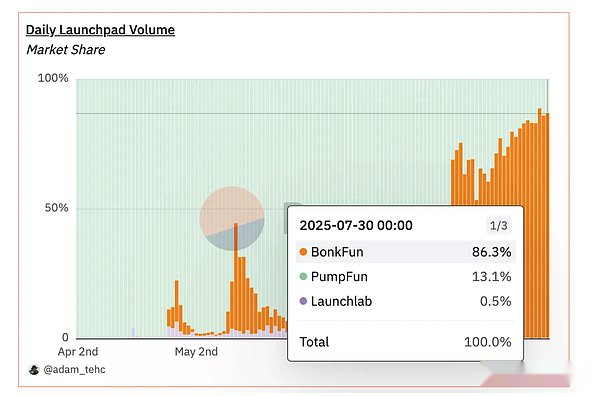
This is not just another manifestation of the “volatility” of the crypto world.This is even more a textbook case of the collapse of the empire:When you forget that attention is the final moat, no matter how big the first-mover advantage is, it will disappear instantly.
How was the Pump.fun Empire established?
To understand the fall of Pump.fun, you must first understand how strong it was.It was launched in January 2024 by three young people in their 20s, and in one sentence it subverted the issuance logic of meme coins:“You upload a dog, breakfast or even a random meme picture, give it a name, click a few times, Boom! You send a coin, the cost is less than $2, and you don’t need any code.”
It satisfies a kind of underlying impulse:Turn something that is “nothing” into something that is “a little value”.In the crypto world, this is not a delusion, it is a business model.By January 2025, Pump.fun created more than$458 million in revenue, thousands of new coins are launched every day, and daily income breaks through at peak times$7 million.
More importantly, it won the attention battlefield—becoming synonymous with the Solana memecoin culture.Whoever wants to issue coins on Crypto Twitter is the default to use Pump.fun.It not only occupies the infrastructure, but also firmly controls the right to speak in culture.Empires developed by their own success often develop weaknesses that competitors can exploit.
The tragedy begins with one of its most “innovative” features:live streaming.
Originally, it was for the issuer to promote his tokens in front of the camera, but you also guessed that things were out of control.Starting from November 2024, in order to attract attention, someone began to do extreme behaviors in the live broadcast: simulated self-harm, threatened suicide, animal abuse, and the most serious time: a minor user threatened his family with a shotgun in front of the camera, just to pull the plate.
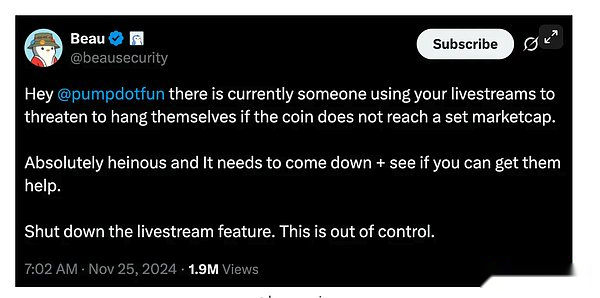
Pump.fun was forced to shut down live streaming features urgently, but his reputation was ruined.The weekly income plummeted instantly66%, public opinion backfires, and competitors began to take advantage of the situation.Faced with the decline in revenue and competitive pressure, Pump.fun made a seemingly smart but actually fatal decision:Coin issuance (ICO) to save yourself.
This ICO was technically successful—raised from more than 10,000 wallets in just 12 minutes$500 million, add another round$700 million private placement.
But if you look deeper, you will find that the old drama is coming again:More than 200 wallets filled the $1 million cap, and the first 340 buyers swallowed 60% of the shares.All sales tokens areFull unlock(No locking), just setTransfer limit period from 48 to 72 hours.
Almost half of the participants poured their wallets within 24 hours – a model that could hint at an organized buying strategy or it could be just a strong interest from retail users in the issuance.
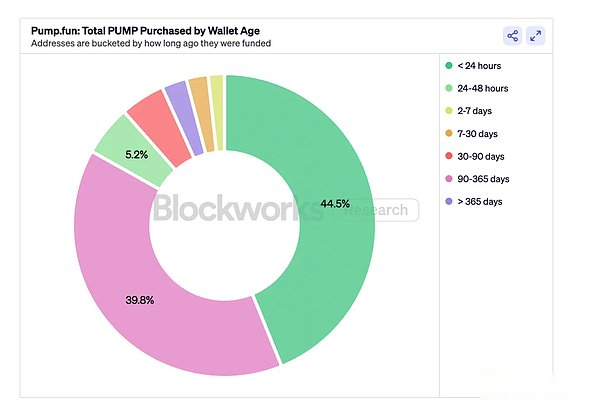
The token price initially soared 75% to $0.007, and enthusiasm quickly cooled down.It fell 60% in a few weeks, setting new lows, a typical “death spiral” trend.Token economics itself is also very radical, with only 33% allocated to public and private equity firms, while the remaining 67% are in the hands of the project party and the allocation schedule is unknown.Of these 33%, 18% are private equity shares reserved specifically for institutional investors.
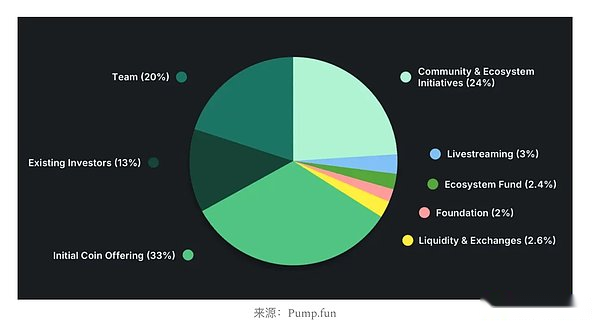
Although users generated nearly $750 million in revenue for the platform, there was no instant community reward; at the same time, private equity investors sold $160 million worth of tokens to the exchange, bringing huge selling pressure.
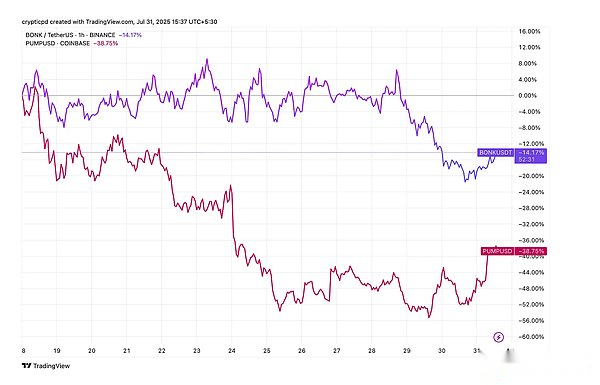
The last straw that broke the camel was that co-founder Alon Cohen publicly announced that the long-promised airdrop “will not happen in the foreseeable future.”
For months, the project has hinted that the upcoming rewards are “will be richer than anyone in the industry”, creating huge market expectations.And just when the community trust is most vulnerable, they announced the cancellation of airdrops.The token price plummeted by 15% in 24 hours.It’s not that the airdrop itself is important, but that the cost of failing promises is extremely fatal.
Bonk Rise
As Pump.fun struck a lot of thunder, Let’sBONK is silently building everything that the opponent lacks: transparency, community orientation, and clear communication.
Currently, Let’sBONK’s daily income has reached $1.3 million, while Pump.fun is only $254,000, a 5-fold difference.On an annualized basis, Let’sBONK earned $434.92 million in a month, compared with Pump.fun’s $267.25 million.
From almost zero in May to a steady breakthrough in daily revenue of one million dollars in July, Let’sBONK’s revenue has been rising steadily.Meanwhile, Pump.fun’s revenue plummeted from its January peak of over $7 million, falling back to its September 2024 level.
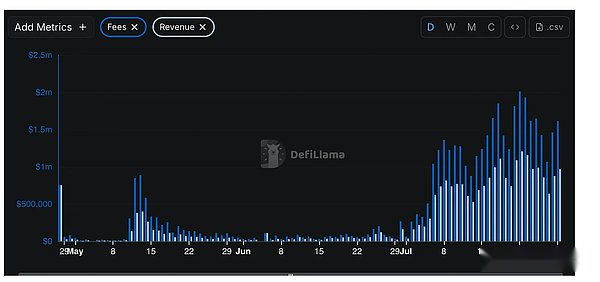
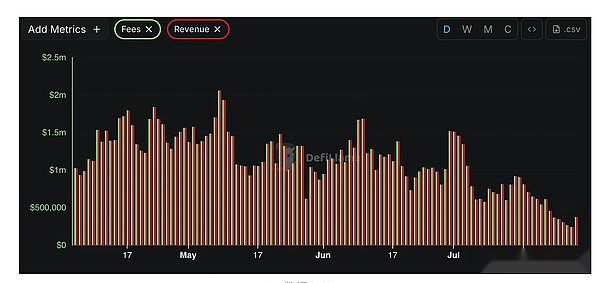
Since the ICO, PUMP tokens have dropped 60% of their market cap, while BONK is relatively stable with a market cap of $2.1 billion.Let’sBONK spends 1% of its revenue every week to repurchase BONK, supporting this ecological token that was earlier than the platform and had a foundation.
Attention Economy
Pump.fun once took the lead with network effects—The reason why developers issue coins there is because the traders are there; the reason why traders are there is because the hottest memecoin is all first-time.This flywheel is spinning faster and faster, and seems unstoppable.
But attention is fragile.It is not like the moat of traditional enterprises – economies of scale, switching costs, and regulatory barriers – as long as trust collapses, the user’s mind will collapse instantly.A live broadcast accident gave users a reason to try to replace the platform.Let’sBONK immediately became a “clean” choice, a platform without historical burden.
It’s like Myspace lost to Facebook back then.Myspace has the functionality and scale, but loses the cultural narrative.Facebook has become a platform for “real users”, while Myspace has become synonymous with spam, chaotic interfaces and marginalization.After realizing the crisis of life and death, Pump.fun launched a nearly desperate counterattack.
First, they increased their token repurchase ratio from 25% of their daily revenue to 100%.Although this means about $254,000 per day is used for repurchases, which is much higher than Let’sBONK’s repurchases of $13,000 per day (only 1%), it also means that Pump.fun uses all its revenue to repurchase rather than use it for platform growth.
Second,They launched a 30-day incentive program that rewards PUMP tokens based on trading activities.However, preliminary feedback shows that this strategy has not reversed the competition.
The problem is not at the tactical level, but at the strategic level.No matter how many repurchase or incentive plans are, it is impossible to regain lost trust and regain the attention of the displaced users.
Pump.fun’s reward mechanism only revolves around transaction volume, while Let’sBONK builds an ecological reward system that is truly bound to user interests.
The BONK reward program allows users to lock their positions for 6 to 12 months and obtain revenue share from product ecosystems such as BonkBot and BonkSwap in proportion.The longer the lock time, the higher the multiplier.The better the product performance, the more users’ returns.This is not “spend money to make people trade”, but “pay money to let users build together”.
Users (including project parties) can obtain “Bonk points” through transactions, purchases or issuance of coins.These points are expected to be exchanged for physical goods or rights in the future, further inspiring active participation.The gamified growth experience makes users feel like they are participating in a bigger mission.
When Pump.fun was still exploring ICOs and short-selling votes were delayed, Let’sBONK already provided a structured reward system for core users.In the crypto world, capital will always flow to better incentive mechanisms.
A bigger pattern
In traditional industries, market leaders often sit firmly on the throne for decades.General Motors has dominated automobile manufacturing for half a century, and IBM has controlled corporate computing for almost as long as it has.In the digital market, the user switching cost is close to zero.The dominance may be destroyed within a few months.
An investigation revealed that Pump.fun co-founder Dylan Kerler had participated in the “pull up shipment” scam in 2017 – precisely what Pump.fun claims to eliminate.In an industry built on trust and memes,The collapse of credibility is equivalent to an existential crisis.
Let’sBONK’s success is not because they built a fundamentally better product, but because they entered the market at the moment when Pump.fun’s reputation is the most vulnerable.In the attention economy, timing is often more critical than technology.
The winner-take-all logic of the network effect begins to reverse.Once users start migrating to Let’sBONK, the flywheel that once caused Pump.fun to rise also begins to reverse.Developers follow traders, traders chase the hottest projects, and the speed of the platform’s decline also accelerates.
Is there still a chance to turn the tables in Pump.fun?Although its market share has shrunk significantly, it has not yet reached the point of being eliminated.
They do have some advantages: the $1.2 billion financing has bought them time and also given them the capital to experiment and survive their opponents.Their platform once supported hundreds of thousands of project releases without crashing—which is especially important in environments where other new platforms are prone to failure under high pressure.Even if the market share declines, they still have more than $250,000 in revenue every day, with an annualized rate of nearly $100 million, and with huge reserves of funds, the foundation is still there.
They are the pioneers of this category.The operation of issuing coins from programming to clicking the mouse has won them lasting brand awareness.The starting advantage is not something that is gone.
The recent actions also show that they have not given up:Pump.fun 2.0 has added real-time data updates and one-click transactions; the repurchase ratio has been increased to 100%; and user incentives have been launched.These are not gestures of giving in, but counterattacks.
The most likely situation is not a complete collapse, but a fragmentation of the market.There are few permanent monopolists in the crypto field.More likely, Let’sBONK became the main platform, dominating the amount of coins issued and revenue, while Pump.fun transformed into a segmented platform with loyal users, occupying a place with interfaces, functions or ecosystems.
But to truly turn the tables, Pump.fun is not just about solving technical problems or saving people by giving money, but about rebuilding trust and reoccupying the cultural highland.This means that to achieve an open, transparent, community-centric token economic structure, it may even require a comprehensive change of leadership to completely get rid of past controversies.
The French court had long understood one truth:When a king loses his legitimacy, no matter how much gold, silver and rituals are, he cannot save his dignity.Only the new ruler can win the respect of the old ones.Sometimes, for the kingdom to continue, the crown must be passed to the newcomer.





